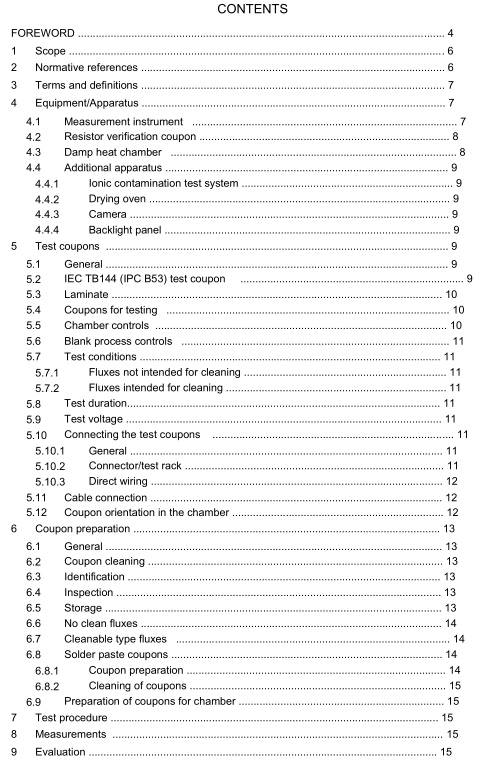IEC 61189-5-501 pdf – Test methods for electrical materials, printed boards and other interconnection structures and assemblies – Part 5-501: General test methods for materials and assemblies – Surface insulation resistance (SIR) testing of solder fluxes

IEC 61189-5-501 pdf – Test methods for electrical materials, printed boards and other interconnection structures and assemblies – Part 5-501: General test methods for materials and assemblies – Surface insulation resistance (SIR) testing of solder fluxes
The instrument can be used with either an external or internal power supply but shall be capable of delivering a variable voltage from (5 to 100) V DC ±1 % with a 1 M Ω load and a channel to channel isolation resistance of 10 13 Ω. The system shall be capable of taking measurements in the time interval required. Equipment shall have the measurement capability to repeat the resistance measurement on all channels at least every 20 minutes.
4.2 Resistor verification coupon The measurement system measurement performance shall be verified by substituting a resistor verification coupon (see Figure 2) in place of the test coupons while in the chamber at both ambient and elevated conditions. This coupon should be fitted with at least 4 “known value” resistors. The tolerances for the “known value” resistors shall be as per the purchased tolerances defined in 4.1.
4.3 Damp heat chamber A damp heat chamber capable of being adjusted to a temperature of 20 °C ± 2 °C to C and of relative humidity between 80 % RH ± 3 % RH and 90 % RH ± 3% RH 100 °C ± 2 ° according to IEC 60068-2-67 and IEC 60068-2-78 shall be used. If the alternative conditions of 40 °C / 93 % RH are to be used, the damp heat chamber shall be capable of the upper humidity level of 93 % RH ± 3 % RH rather than the 90 % RH ± 3% RH specified above. See 5.7.1 and Clause A.4 for additional information.
The chamber should be constructed with stainless steel inner surfaces and be well insulated. The temperature and humidity measurement should be taken using sensors such as dry and wet bulb thermometers or solid-state sensors. The temperature and humidity levels of the test chamber shall be recorded at a minimum of 5 minute intervals throughout the test, preferably with independent control sensors. The location of the samples within the chamber should ensure that the airflow within is not impeded. Adequate mixing of water vapour and air is imperative to ensure condensation does not occur anywhere in the chamber except on/around cooling or dehumidification coils. If any part of interior of the chamber is below the dew point, possibly due to insulation or control issues, condensation will occur. The samples shall be kept above the dew point and be shielded from dripping or flying condensate.
The chamber interior shall be free from any unwanted residues from previous tests. Thechamber should have been dedicated to heat and humidity testing only and not used for tests
such as salt fog, salt mist or salt spray.
4.4Additional apparatus
4.4.1lonic contamination test system
lf the user does not have an ionic contamination test system, as described in IEC 61189-5-504,then the following additional items shall be needed:
. lint-free handling gloves;
three 2 l beakers;
exhaust ventilation hood;metal tongs;
soft bristle brush;
deionised or distilled water maximum 15 uS/cm of sufficient volume to carry out cleaning asper 6.2;
-propan-2-ol (IPA) of sufficient volume to carry out cleaning as per 6.2.4.4.2Drying oven
Capable of maintaining at least 50 °c.4.4.3Camera
A camera for recording full colour photographs of test coupons.4.4.4Backlight panel
Suitable for inspecting test coupons after testing for evidence of dendritic growth or otheranomalies.
5Test coupons5.1General
lt has been the practice for different test coupons to be used that has led to confusion in respect
to comparing test results. In addition, previous revisions of this and other test methods,haveconflicting requirements in respect to the voltage gradient and test voltages to be used.Toresolve this confusion,a comprehensive “round-robin” research study was conducted thatemployed a new test coupon that includes test pattern characteristics’ of the following testcoupons: IPC B24; “Bellcore”; lEC61189-5 Method 5E01.
The full technical report IEC TR61189-5-506of this separate research study should bereviewed.
5.2IEC TB144 (IPC B53) test coupon
The test pattern lEC TB144 from lIEC TR61189-5-506,now known as lPC B53 and shown inFigure 3, shall be used for the test coupon.The 6 comb patterns comprise A and F patterns of
0,4 mm line width and 0,2 mm spacing, comprising 5 125 squares (IEC 61189-5 Method 5E01);Band E patterns have 0,4 mm line width and 0,5 mm spacing, comprising 1 020 squares (IPC’
B24); C and D patterns have 0,318 mm line width and 0,318 mm spacing,comprising 1 950squares (Bellcore).









